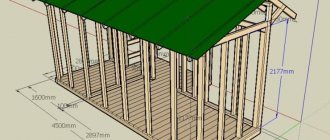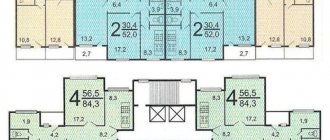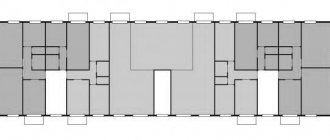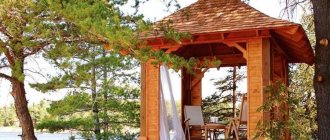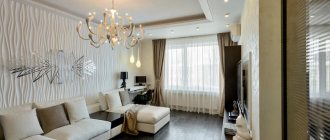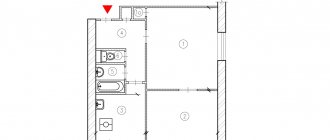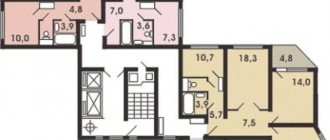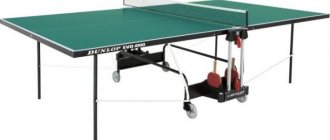A swimming pool is a complex hydraulic structure that includes a bowl filled with water, a filtration system, lighting equipment and sometimes even heating. A separate, but often necessary addition is the roof.
With it, the tank remains clean longer, and owners can take water treatments during rain. There are several ways to make an indoor pool at your dacha with your own hands. Each type of canopy has its own advantages and installation nuances.
Swimming pool under a telescopic roof
Why do you need a roof?
Both adults and children love to swim, especially if it is very hot outside. In addition, swimming in the fresh air is good for your health.
Clean water in the pool - leaves and other debris do not fall into it
A large reservoir at the dacha is a good supply of water, which will be useful during drought for watering the garden. This symbiosis is very beneficial.
Since watering must be regular, the water in the pool is changed frequently, so that it remains clean even without the use of filtration equipment. Only a minimum of chemicals will be required (you can learn about pool water purification from the article on our website).
Swimming pool in the country with a polycarbonate roof
Advantages of a canopy over a pool
What does a canopy do? After all, you can sunbathe in the open sun and not waste time and money on roof installation.
Let's note the advantages of using a roof for a pool:
- Any roof, even transparent, will partially reflect and dissipate heat, which solves this problem.
Swimming pool at the dacha under a roof on rails - The roof prevents leaves from tall trees growing nearby from getting into the pool. Also, birds will not shit in it and insects will not fly into it.
- If the pavilion above the pool is low and made in the form of a dome, it does not allow water to evaporate. Also, due to the reduced amount of ultraviolet radiation entering the water, the chlorine necessary for disinfection will not evaporate as actively.
The pool is completely closed from debris, although the owners will have to worry more about caring for the roof itself - Wind and rain will not interfere with swimming. Some pool covers eliminate these inconveniences and allow you to use the pool all the time.
- It happens that the canopy performs a purely camouflage role. For example, the neighbors have a two-story house from which the yard with a swimming pool can be seen at a glance. Those who do not want to expose themselves can hide behind a small, light roof.
Such a lightweight awning will protect the pool from blowing - A roofed pool can be combined with a greenhouse. This creates a unique humid atmosphere inside, which is necessary for some vegetables and fruits. For example, cucumbers in such conditions will grow incredibly quickly, and the fruits will be very juicy.
Swimming pool inside a greenhouse – combining business with pleasure - A greenhouse can be without plants. With such a roof, the water warms up faster and stays warm longer. This is convenient in regions where summers are not very hot.
Indoor swimming pool at the dacha made of polycarbonate - this height of the canopy will allow you to swim even if it is closed - Another plus is the unusual design that pleases the eye.
Disadvantages of using a roof over a pool
Of course, a canopy over a pool also has its disadvantages:
- Even a light frame roof will cost a lot, let alone profile telescopic sliding models installed on stationary pools.
However, it is worth considering that if the water in the pool gets dirty quickly, it will have to be changed frequently. Over the course of a season of operation, this can result in additional expenses of up to 10-15 thousand rubles, so the price of the roof will be gradually compensated. - The pavilion is installed mainly over stationary pools or powerful frame models. For temporary ones, this solution is not entirely suitable.
Canopy for a swimming pool at the dacha
- Installation of complex telescopic systems will require additional space, which may not be enough on site.
- If the pool itself remains clean, the roof above it will take all the “blows” and will have to be washed at least once a month, but it is better to do this more often and with the help of cleaning products.
This pool is made as an extension to the house
- If the roof above the pool is low, a greenhouse effect may be created underneath, making swimming less comfortable. Condensation will form on the roof, so it is worth providing good ventilation.
The photo shows how the owner covered his light frame pool at the dacha with an awning tent. An excellent, and most importantly, inexpensive solution that will not protect except from strong winds.
Swimming pool for a summer house with a roof - a ventilated awning is used
Protective decking covers
A non-standard individual solution among protective coverings for outdoor swimming pools is the WALTER deck (France). This is a multifunctional mobile terrace cover for a swimming pool, which has an additional function: when closed, it serves as a recreation area.
It consists of mobile modules made of a metal frame, covered with any finishing material. 100% protection of the pool, which does not require additional coating, and an attractive design appearance - this is what distinguishes this type of pool cover.
Selection of types, shapes and sizes
Swimming pools come in different types, each with its own set of characteristics. Installation methods also differ.
Types of pools
A different roof can be installed for each type of pool.
- Stationary pools are large tanks that are not designed to be moved. They are permanently installed and have a solid foundation, which is installed in the ground. Their dimensions can be very large, so the appropriate roof must be used. In dachas, such tanks are rarely found due to their high cost.
Fixed pool under a large retractable roof
- Mobile pools are the second group, which is divided into frame and inflatable. Frames can also be three-dimensional, and some models reach the size of stationary ones. Only they don’t go deep into the ground, and they stand on a flat area. The roof over such a pool can also be made permanent, but awning tents are more popular.
Large frame pool covered with a film tent
- The second category of mobile products is inflatable. In size they can be comparable to small frame pools with a diameter of no more than a meter. There is no point in building a separate roof for such pools at all - you can install them under a canopy, and for children, buy a model with an inflatable roof, as shown in the photo below.
Children's inflatable pool with roof
Large inflatable pool under a folding roof
Types of roofing
Depending on the type of roof, the specifics of installation and roof materials are determined.
| Roof type, photo: | Description: |
Stationary swimming pool for a summer residence - extension to a house | If the pool is located near the house, made as a stationary one, the roof above it can be tied to the main building. The photo shows that the owners equipped a separate room, which was lined with ceramic tiles. The design of the fence turned out to be semi-open - some of the walls were raised from blocks. The roof and front part are made of frames. For this, a metal profile and glass were used. The entrance inside is made in the form of simple swing doors. |
Arched telescopic model | For stationary models of any size, a lightweight telescopic roof in the form of an arch will be a good addition. It is made of polycarbonate and a lightweight aluminum frame. Parts of the canopy move along rails running along the bowl. This may not please everyone, as you will constantly have to step over them. The photo shows that the pool has a double roof - the first encloses the room, and the second only the tank. |
| Dome roof | For pools that do not have the shape of an elongated rectangle, domed roof models are suitable. Functionally, they resemble the previous version in many ways, but they cannot be opened completely - this is done only in segments. The sections also move on rails, rotating around an axis in which a complex mechanism is installed. Such a pavilion will cost much more. She looks beautiful, but is more difficult to care for. It is also worth providing for the possibility of access to the central axis of the roof for its maintenance. |
Awning tent | A frame awning over a small pool is the most realistic option for a summer cottage in the Russian Federation, since a small number of people can boast of a stationary one. The price of such an awning ranges from 3 to 10 thousand rubles, depending on its size and quality. |
Mobile folding systems | This photo shows the version on wheels, which can also be folded and moved. This roof is made of transparent and opaque film. It has a lightweight aluminum frame. This solution is convenient and functional. |
Ball-shaped folding structures | In fact, we have before us a variation of the previous roofing option, only with limited mobility. This roof is good for small frames. Before bathing, it folds up and then returns back. Its disadvantage is that it is inconvenient to swim under, and oxygen access is limited. |
| Swing mechanisms | Many stationary frame buildings are also used. They do not fold like the previously discussed models. The presented photo shows that all sections are sliding - the polycarbonate rises up along the guides, like blinds. You can use ordinary doors - it all depends on the shape of the project and its size. |
Polycarbonate canopies for pools in the country | The simplest roof is a canopy. It can have any convenient shape and size. The canopy can be attached to the house or stand alone. |
There are a lot of roofing options for a swimming pool. There are also complex combined solutions that combine different mechanisms.
Complex multi-component roof on a wooden profile
So, for any country pool, light awnings and a polycarbonate frame roof are good options in terms of price and quality.
Materials for making a pool roof
When choosing a material for a future roof, it is worth considering its capabilities and features.
- Aluminum is used for the manufacture of profiled frames of varying complexity and sizes. The material is strong enough to withstand loads, including snow. It is lightweight, easy to care for, and does not corrode.
Aluminum frame
- Steel is a fairly heavy metal, but has greater rigidity. For work, pipes and profiles of different shapes and sizes are taken. Steel corrodes from moisture, so it must be painted. The painting is periodically renewed, otherwise the product will become unusable after some time. It is used for simple, fixed frames.
Attention! Steel parts can be galvanized - the coating protects them from rust.
Small canopy - frame construction
- A wooden frame is the most expensive, since the material must be bent correctly and processed efficiently to protect it from moisture. But the exterior of such a roof will be amazing. Both fixed and moving systems are made from wood.
Glued laminated wood is used for the powerful frame.
Mostly transparent materials are used to fill the frame:
- Glass is suitable for large stationary canopies that do not use curved elements. For the roof, it is worth choosing an impact-resistant option in case of hail. This solution is expensive, but it has no equal in beauty.
All transparent roof parts made of glass
- Polycarbonate is a polymer, impact-resistant material. It can be solid or cellular. The first one is similar to glass, it is durable and costs more. The second is cheaper - strength is achieved due to the honeycomb structure.
- Polycarbonate comes in different colors. Tinted brown is very popular. It transmits light, but is not completely transparent, as can be seen in the next photo. Thanks to this, it provides good protection from the scorching sun.
Polycarbonate roof
- PVC and other films. Summer residents love this material, as it allows them to make a large and reliable roof with a modest investment. Disadvantages: low strength in contact with sharp objects. Heavy hail can also penetrate the material.
Film roof over frame pool
- Awning fabric is a fairly durable material that matches the characteristics of films. However, the awning is stronger and does not allow light to pass through.
The awning roof provides good protection from the sun
Cases with fastening device (rail system)
Covers for stationary pools are divided into 2 categories : with a rail system and fastening devices. Covers equipped with a fastening device protect the pool with a special cover made of reinforcing mesh or vinyl reinforced with stitched braid.
They are installed using adjustable clamps and springs, which are attached to anchors mounted on the formwork. Such covers are quite heavy and only professionals can install them. With the development of modern technology, it has become possible to order a cover with your own special design to cover an elevated spa, steps, water and stone inserts inside the pool.
As for cases with a rail system , they are considered the most expensive. These shelters consist of an entire roll of vinyl that is stored on a drum, reel or reel system. The vinyl is attached to tracks (rails) that run the entire length of the pool.
Such covers are available manual and automatic. The manual shelter model assumes that someone
turned the handle to open and close the case. It requires manual force and is therefore only suitable for small pools. In the automatic version, everything is much simpler; an electric motor is used here. Therefore, it is not at all surprising that this version costs several times more.
Do-it-yourself pool canopy at the dacha
Most awnings are either made to order or purchased ready-made. However, it is not always possible to find a roof of a suitable size, so some decide to build it themselves.
Indoor swimming pool project for a summer residence
The procedure depends on whether the pool has already been built or not. However, in any case, you will need to draw up a project or at least a simple drawing.
To do this, use 3D programs or online services. You can also remember school drawing lessons and do everything on paper.
Pool roof project in 3D program
When drawing up a drawing, it is important to consider the shape, dimensions of the canopy and all the materials that will be used.
Canopies made of polycarbonate - a drawing on paper is in no way inferior if all proportions are met
If a profiled frame is not acceptable, it is best to work with steel pipes. This material is very durable, so making an unreliable roof is problematic, even without carrying out calculations.
Having a pipe bending machine, they can be given any shape.
The strength of the structure should always be calculated with a margin, so that when snow falls, nothing bends, much less collapses.
Points to consider when drawing up a project
The easiest way is to install a canopy over the pool. This design is motionless, that is, it does not have complex mechanical parts.
The roof of the canopy should be made sloping so that the sticking snow can come off on its own. If the pool is semi-outdoor, I provide additional awnings to cover it for the winter (read the article about preparing the pool for winter).
DIY pitched canopy over the pool
Preserving the pool for the winter
Vinyl covers
Vinyl covers for swimming pools WALTER (France) are an alternative innovative development of French specialists. Vinyl covers are offered in a variety of designs and modifications, such as automatic roll-up covers and removable covers.
This type of cover is ideal for winter. A wide range of vinyl colors, construction types and ease of use make this covering increasingly popular.
Video - Vinyl protective coatings
Where and approximately at what cost can I buy it?
Pool covers can be purchased at specialized stores that sell accessories. The most convenient option is to use online stores, where they offer the widest range and you can choose any type of covering without leaving your home. Prices for protective sheets depend on their type, size and other features.
For example, awnings cost 500-800 rubles. (per m2), solar blankets are in approximately the same price range. The cost of canopies or pavilions is much higher and starts from 5,000 rubles. (for small mobile folding models).
Decorating the walls of the room
A wide variety of materials are used as decorative coverings for walls and ceilings in the interiors of swimming pools in private houses with indoor swimming pools:
- artificial and natural stone ;
- moisture-resistant photo wallpaper ;
- ceramic and photoceramic tiles ;
- mosaic;
- gypsum;
- decorative panels ;
- flexible stone;
- siding;
- plaster and other options.
Painting, artificial stone and decorative lighting Source www.drive2.com
Wall cladding with artificial stone Source www.spaness.de
Using moisture-resistant photo wallpaper in pool interior design Source artsten.ru
Photo wallpaper “Pebbles” Source artsten.ru
Glass panel with photo printing Source tr.skopelitissa.com
Mosaic panels on the walls of the room and bowl Source d-core.ua
Gypsum panels Source mywallart.ru
LED 3D panels Source 7d-project.ru
Flexible stone cladding is a natural material that consists of a section of sandstone and a textile base, connected with a polymer Source tr.skopelitissa.com
Plastering, wood siding and vertical gardening Source houzz.es
Pool room with vertical landscaping Source www.mastyk.ru
To save money
You can save on building materials during the construction of a swimming pool inside your home. For example, instead of expensive polypropylene, you can use hydrofilm. A durable film is applied to the erected frame and strengthened - first on the bottom, then on the side of the pool, leaving holes for filling and draining water, filtration, and cleaning. We coat the joints and top parts with sealants. Ceramic tiles are also cost-effective; porcelain stoneware; glass mosaic. If you want to save money and a country style suits your pool, you can line the walls and floor around the bowl with clapboard or weathered wooden slabs - waterproof and not subject to changes in humidity and temperature.
Product installation procedure
The procedure for installing protective covers should be familiar to every pool owner.
Awning
Installing an awning is the most labor-intensive procedure. Most of the paintings have to be placed manually, which requires the participation of one or two assistants.
Procedure:
- the canvas is laid from the end of the bowl (or from one edge if it is round);
- two people take hold of the edge of the canvas from different sides of the bowl and simultaneously pull it, trying not to make folds or distortions;
- when the entire area is covered, the cover is leveled again and secured with cables.
Sometimes the participation of a third person is required to straighten the canvas and prevent it from overturning the sides of the frame pool.
Dome
The dome is installed in accordance with the instructions. As a rule, folding models are installed in the following order:
- The folded frame is placed in the right place.
- The frame elements are straightened and moved into working position. It is fixed using special elements.
- If the canvas is installed separately, it is laid and secured.
Installing a folding canopy is no more difficult than installing a camping tent. The main thing is to act carefully and not damage the transparent film.
Pavilion
The pavilion is a permanent structure . In order to cover the pool, you need to move the movable sections so that they hide the entire area of the bowl.
This is a simple procedure, and on large structures it is also automated - when you press a button, the sections are moved using servos and stop at specified positions.
Design Features
Simple geometric shapes (square, rectangle, circle, oval) are combined with any architectural style and landscape. Round-shaped terraces and pools are cheaper than rectangular ones, and installers often charge based on the size of the perimeter. Structures of complex shapes, for example, L-shaped, are built in cases where you want to preserve important objects on the site: boulders, trees, etc.
During the design stage, it is important to provide sufficient space around the perimeter of the pool. This is for safety and to reduce water pollution. Experience shows that the optimal width of the flooring is 1.5-2.5 m.
It follows that the higher it is, the more expensive the structure and the more limited access to the recreation area and water.
A terrace that is too low or high often has to be additionally fenced. To climb onto the high deck, you will need steps.
As for the depth of the pool, 1.2-1.5 m is enough for free swimming. It is recommended to create a separate shallow area for swimming small children. For those who want to swim far, it is better to make a pool in the shape of the letters L, P.
It is difficult to competently build a terrace with a monolithic concrete pool. It is better to involve an architectural designer, designers and builders with experience in such work. But you can easily build a wooden deck for a vinyl or fiberglass pool with your own hands.
Pneumatic (inflatable) domes
Pneumatic domes are the most affordable of all roof-shaped structures . Inflatable structures have a simple design and are easy to install. The fans regulate the air flow into the vinyl bag, and once the canopy reaches its maximum value, the air pressure continues to maintain it in an inflated state. Doors with zippers are equipped with transparent screened windows. Removing such a coating is not at all difficult; to do this, just turn the switch on the fan.
As a result, the structure instantly deflates, and for ease of storage it can be rolled up at your discretion. Despite the fact that inflatable structures serve their owners well, one should not forget about their service life, because such shelters are very susceptible to frequency of use and the wearing influence of weather. The fabric of the inflatable dome has a special coating against UV radiation, but it is inferior in service life to permanent structures.
What types of shelters are there?
There are several types of pool covers:
- awning;
- cover;
- solar coating;
- trampoline covering;
- roller protection;
- canopy;
- dome;
- pavilion;
- permanent building.
Protection options are listed in order of increasing complexity of construction and installation. Some of them are structures that require full-fledged and expensive construction. Others are simply canvases of various types of film, laid directly on the water or suspended on the sides.
Temperature preservation
Radiators, convectors or heated floors help maintain the temperature at a comfortable level. For small indoor ponds, one of these types of heating may be sufficient, since the pavilion serves as a kind of greenhouse. For larger structures, heated floors alone may not be enough.
Heater for indoor pool
Water is heated by flow-through heaters, which can be electric or heat exchange. Electric ones heat the water, after it is collected by the filter, purified and returned warm to the reservoir. This may not be enough for indoor pools with a large volume of water. In this case, a heat exchange system is used in which water is heated in a separate tank and then mixed with cold water.
